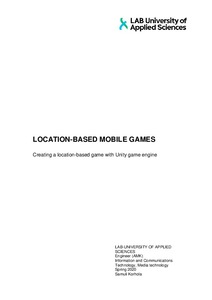Product gamification of Marisonia system : Unity 2022 and Unreal Engine 5 comparison
Turan, Irem Deniz (2025)
Turan, Irem Deniz
2025
All rights reserved. This publication is copyrighted. You may download, display and print it for Your own personal use. Commercial use is prohibited.
Julkaisun pysyvä osoite on
https://urn.fi/URN:NBN:fi:amk-202505059142
https://urn.fi/URN:NBN:fi:amk-202505059142
Tiivistelmä
This thesis explores gamification in simulating the installation of the Marisonia ultrasonic anti-biofouling system using Unity 2022 LTS and Unreal Engine 5. It compares both engines in creating interactive, educational, and engaging simulations to enhance user learning and product understanding. Key components such as ocean environments, camera systems, player movement, AI feedback, and user data collection were implemented in both platforms.
Unity excelled in modular development and cross-platform use, while UE5 provided superior realism, AI-driven interaction, and built-in analytics. AI feedback and real-time event tracking enabled adaptive learning and engagement, supported by heatmaps and session logs. The findings show that gamification combined with AI and data tracking boosts training efficiency and user retention.
The study concludes that Unity is ideal for lightweight, flexible applications, whereas UE5 is better for immersive, high-fidelity simulations. These insights support future gamified training and marketing solutions in sectors like marine technology. This thesis explores gamification in simulating the installation of the Marisonia ultrasonic anti-biofouling system using Unity 2022 LTS and Unreal Engine 5. It compares both engines in creating interactive, educational, and engaging simulations to enhance user learning and product understanding. Key components such as ocean environments, camera systems, player movement, AI feedback, and user data collection were implemented in both platforms.
Unity excelled in modular development and cross-platform use, while UE5 provided superior realism, AI-driven interaction, and built-in analytics. AI feedback and real-time event tracking enabled adaptive learning and engagement, supported by heatmaps and session logs. The findings show that gamification combined with AI and data tracking boosts training efficiency and user retention.
The study concludes that Unity is ideal for lightweight, flexible applications, whereas UE5 is better for immersive, high-fidelity simulations. These insights support future gamified training and marketing solutions in sectors like marine technology.
Unity excelled in modular development and cross-platform use, while UE5 provided superior realism, AI-driven interaction, and built-in analytics. AI feedback and real-time event tracking enabled adaptive learning and engagement, supported by heatmaps and session logs. The findings show that gamification combined with AI and data tracking boosts training efficiency and user retention.
The study concludes that Unity is ideal for lightweight, flexible applications, whereas UE5 is better for immersive, high-fidelity simulations. These insights support future gamified training and marketing solutions in sectors like marine technology.
Unity excelled in modular development and cross-platform use, while UE5 provided superior realism, AI-driven interaction, and built-in analytics. AI feedback and real-time event tracking enabled adaptive learning and engagement, supported by heatmaps and session logs. The findings show that gamification combined with AI and data tracking boosts training efficiency and user retention.
The study concludes that Unity is ideal for lightweight, flexible applications, whereas UE5 is better for immersive, high-fidelity simulations. These insights support future gamified training and marketing solutions in sectors like marine technology.
Kokoelmat
Samankaltainen aineisto
Näytetään aineisto, joilla on samankaltaisia nimekkeitä, tekijöitä tai asiasanoja.
-
Game Development in Unity : Game Production, Game Mechanics and the Effects of Gaming
Dansie, Jason (Metropolia Ammattikorkeakoulu, 2013)The goal of this thesis is to examine how video games are designed and to see how differ-ent game mechanics work and how to use them in the development of a game, as well as examine what are both the positive and negative ... -
Location-based mobile games : creating a location-based game with the Unity game engine
Korhola, Samuli (2020)The subject of this thesis is location-based mobile games. Location-based mobile games are a way for mobile games to combine reality with virtual worlds and thus re-define the gaming experience. This thesis presents ... -
”WE WANT A 3D GAME” : Customer expectations for the games company when buying a serious game
Sorppanen, Mikko (Oulun seudun ammattikorkeakoulu, 2012)All digital games are not used for entertainment. Some of them can also be used for non-entertainment purposes and these games are called serious games. This thesis is carried out in co-operation with one Finnish games ...


